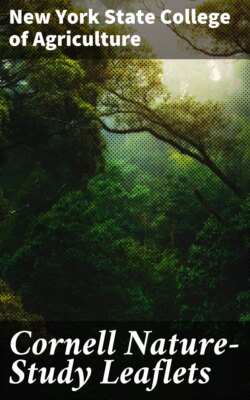Читать книгу Cornell Nature-Study Leaflets - New York State College of Agriculture - Страница 12
3. General Exercises.
Оглавление12. History.—When was the land set aside for a school? When was the school house built? Who built it? (History, language.)
13. Cost.—Try to find out what the land cost. What the building cost. Are they worth as much now? (History, language.)
14. Government.—Determine what officers have general control of the school. How did they come to be officers? How long do they hold office? What are the duties of each? Determine whether your school receives any aid from the State. (Government.)
15. Improvement.—Tell what you think should be done to improve the school grounds and the school structures. (Language.)
16. Photographs.—The teacher or some pupil should photograph the school premises, and send the picture to us. We want at least one picture of every rural school house and grounds in the State. Even a very poor photograph is better than none.
Experiment Garden.—Every school ground should have at least one small plat on which the children can grow some plant that is useful in that community. Just now alfalfa is demanding much attention from farmers, and it is certain soon to become a very important farm crop in New York State. It is used for pasturage and for hay. When once established, it lives for years. It is allied to clover and is a handsome plant for any school grounds. Will not the teacher suggest to the children that they make an alfalfa bed along one side of the school grounds? It will be attractive and will teach many lessons to pupils and parents even if it is only a few square feet in size. We want to put an alfalfa plat on every rural school ground in the State. We will supply the seed free. Alfalfa is easy to grow if only a few essential principles are kept in mind. We will send full directions to any one who applies. From year to year we will give nature-study lessons on these alfalfa plats.
We are anxious to start work of the above kind. It can be done at any time of the year. We are already in touch with more than 400 school grounds, but we want to reach every rural school ground in the State. Will not the teacher send to us the best piece of work done by any pupil in any of the foregoing sixteen problems? These papers we will file, as showing the conditions of the premises of the particular school. They will enable us to see the progress that is being made from year to year in the improvement of your school premises. They will also enable us better to give advice, when called upon to do so. Sometimes we can send to the particular school a man to give advice on the spot. Sending the best reports to the University will be a reward to the most diligent pupils. Send all reports to John W. Spencer, Nature-Study Bureau, Ithaca, N. Y.
We desire to put in the rural school houses of the State some good pictures of country and farm scenes. These pictures will be artistic reproductions of meritorious photographs, and large enough to hang on the walls of the school room. With each picture will be sent instructions for framing in order to make the picture more attractive. We shall choose eight such pictures for distribution the present school year. We will send one of these pictures free to any rural school in the State that takes up two of the problems given above; and all of them to schools that take up the sixteen problems. We expect to publish lists of all schools, with teachers' names, that take up this work in improving the premises of rural schools.
Fig. 7. Junior Naturalists making ready for planting. Tompkins Co., N. Y.
To one who is not teaching in the public schools, all this work seems to be simple enough. Such persons are likely to be impatient that more rapid progress is not made in introducing agricultural and common-life subjects into the schools. But the teacher knows that all this work requires patience and skill. It cannot as yet be forced into the schools and still retain spontaneity and vitality. It must come gradually, and prove itself as it goes. Probably all public school teachers are now agreed that the schools should be put closely in line with the life of their various communities. The questions now to be solved are chiefly those of means and methods, and of arousing the school constituencies to the new points of view. A full and free discussion of the whole subject is now needed. The time is hardly yet ripe for very definite courses of study in these new fields. Many schools are already teaching these new subjects with entire success: these schools can serve the cause by making their experience public.
